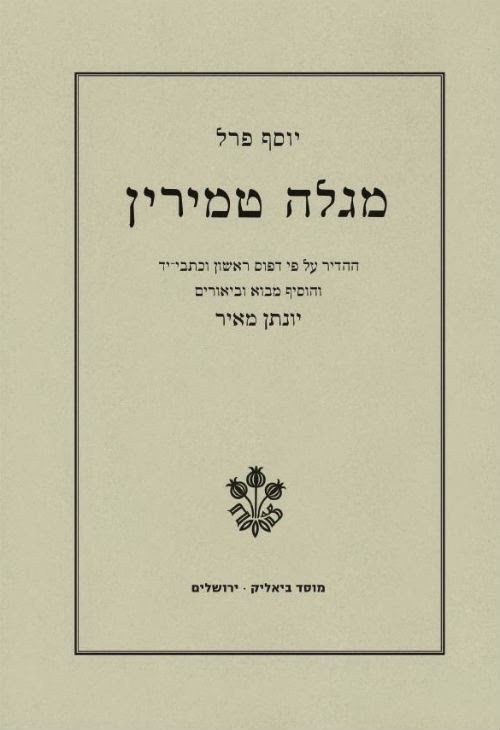New book Announcement- Megale Temirin: Special sale
New book Announcement- Megale Temirin: Special sale
by Eliezer Brodt
יוסף פרל, מגלה טמירין, ההדיר על פי דפוס ראשון וכתבי-יד והוסיף מבוא וביאורים יונתן מאיר, מוסד ביאליק. ג’ חלקים. כרכים ‘מגלת טמירין’ כולל 345 עמודים +מח עמודים; כרך ‘נספחים’ עמ’ 349-620; כרך ‘חסידות מדומה’ עיונים בכתביו הסאטיריים של יוסף פרל, 316 עמודים.
Megale Temirin (Revealer of Secrets) ed. Jonatan Meir. Three volumes, Mosad Bialik, Jerusalem
This is a short description of the work:
Megale Temirin, was first published in Vienna in 1819, and is considered one of the sharpest and wittiest pieces of Jewish literature written in the first half of the nineteenth century. It is perhaps the most important piece of Hebrew prose composed before the stories of Mendele Mocher Seforim. A sly and complex story deriding Hasidism and Hasidim, it is told through the correspondence between the beadles of Hasidic courts and contemporary rabbis. It presents a dark picture of avaricious frauds and swindlers whose main concern was control over territory and the souls of believers, a goal achieved by beguiling the authorities and attacking all opponents. Perl lends his book a ‘Hasidic’ feel both in its physical design and in its language, presenting a Maskilic version of the classic work Shivchei Habesht– that lays Hasidism bare so that no reader will ever be able to look at that, or any other Hasidic book, in the same way again.
In addition to the book’s satiric sting, which would have been enough to bring its readers a dual pleasure, Perl’s hints at contemporary people and places, hidden within anagrams and numerological tricks. With the unraveling of these clues, which also include the use of actual Hasidic sources, the book is a valuable, contemporary view of historical reality. A meticulous reading of the book may therefore open a window on the hidden worlds of Hasidism and the Haskalah at the start of the nineteenth century.
The first volume (Imagined Hasidism) of this collection serves as an introduction to the complex satirical writings of Josef Perl of Tarnopol (1773-1839). At the center of the book stands an analysis of the satires, Megale Temirin (1819) and Bochen Tzadik (1838), including a systematic treatment of the ‘characters’ in the central works and a discussion of the dozens of manuscripts to be found in the Perl Archive in Jerusalem. Perl’s writings are analyzed here in the fuller context of Hebrew and Yiddish literature in general and Maskilic and Hasidic literature in particular, as well as other polemical writings and governmental records critical of Hasidism. The study thus presents a complex and nuanced picture of the relationship between literature and history, between the anti-Hasidic reports and the more complicated historical reality, and lays the groundwork for further research into the genre of nineteenth-century Maskilic satire.
The second and third volumes (Megale Temirin) present for the first time an annotated edition of Megale Temirin. It is based on the first
edition and the scattered manuscripts and it includes a comparison to its Yiddish translation. The book is accompanied by appendices on its origins and contents, including fundamental treatments of several passages: an explication of the encoded names, the Hasidic sources used by the author, and the variants found in the manuscripts and in the only edition of the book in Yiddish.
edition and the scattered manuscripts and it includes a comparison to its Yiddish translation. The book is accompanied by appendices on its origins and contents, including fundamental treatments of several passages: an explication of the encoded names, the Hasidic sources used by the author, and the variants found in the manuscripts and in the only edition of the book in Yiddish.
The editor of the book, Professor Jonatan Meir, teaches in the Goldstein-Goren Department of Jewish Thought at Ben-Gurion University. He has published numerous articles and books on the Haskalah of Eastern Europe, Hasidism, and a number of varied topics in twentieth-century Kabbalah.
For a Table of Contents or more information about purchasing this work, feel free to contact me at Eliezerbrodt@gmail.com
